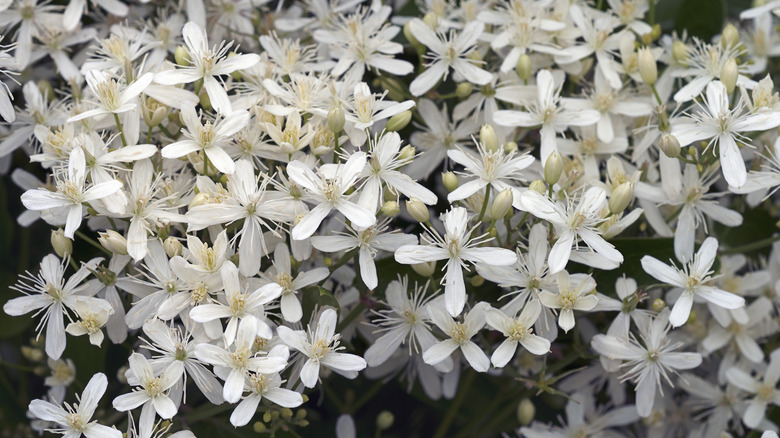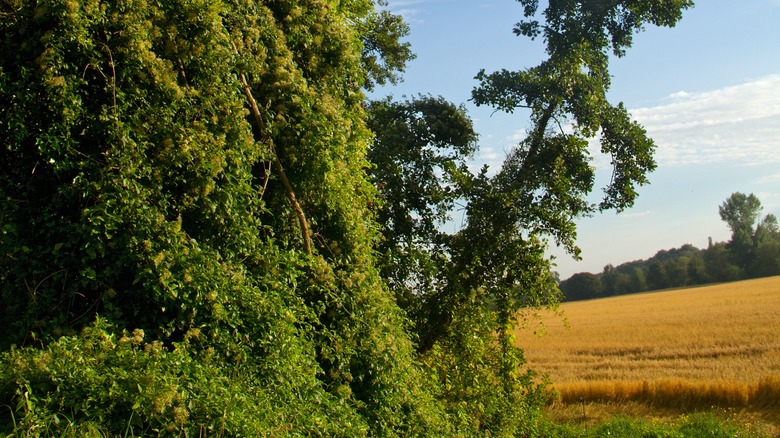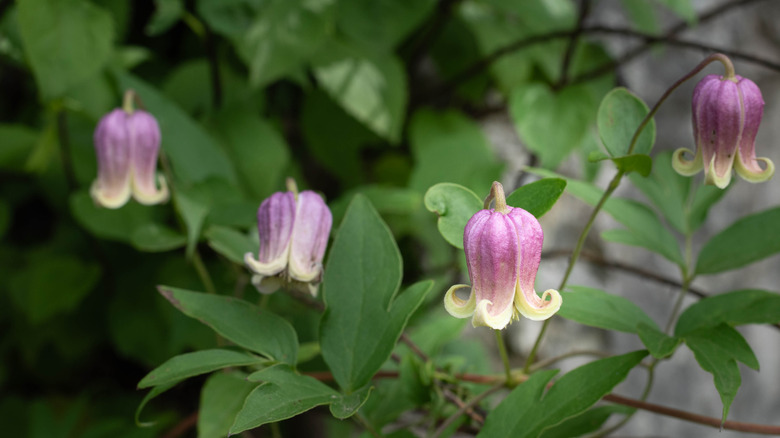Invasive Clematis Varieties You'll Regret Planting In Your Garden
It's hard to look at cascades of lovely flowers and see them as a threat. Clematis vines are some of the best climbing plants for your garden. They're pleasing both to humans and to pollinators, right? Well, that's not the case with a few kinds of clematis. A handful of species are guests from overseas, and they have worn out their welcome. Innocent-sounding sweet autumn clematis (Clematis terniflora), traveler's joy (Clematis vitalba), and orange-peel clematis (Clematis orientalis) are three invasive weeds that are extending their reaches. Spreading beyond state and regional borders, these pests are definitely ones to nix from your gardening plans.
Invasive vining plants are like the horticultural version of a snowball; as the plants spread, their ill effects grow at a frightening pace. Introduced vines like some varieties of morning glories, vetches, and jasmines take over their new spaces and choke out native species. Do your part to protect biodiversity and steer clear of introduced clematis species. There are plenty of native species that will fill any void left in your garden space.
Common invasive clematis varieties
Delicate and colorful, invasive weeds are easy to mistake for flowers. Stretching down the East Coast and working its way west, sweet autumn clematis has established itself as an invasive species in over 10 states, hiding behind other innocuous names, like Japanese clematis and sweet autumn virgin's bower. It can climb quickly up to 30 feet high in blanket-like mats that block out sunlight for native plants.
In the high, dry, and coastal west, a clematis duo is causing trouble. Chinese clematis (also known as orange-peel clematis) and traveler's joy are making the lists of noxious weeds from Colorado to California. Chinese clematis is a concern in some of the western mountain states, but it is showing up in areas beyond the Rockies. Its tenacious vines grow up to nearly 30 feet long and can completely cover trees, rocks, and structures nearby.
Traveler's joy, or old man's beard, is concentrated mainly in California and the Pacific Northwest, but it is making appearances as far east as Maine. Similar to other invasive clematis species, traveler's joy infestations can fully cover trees, bushes, and other plants in its wake. Depending on where you live, certain invasive clematis species pose more of a current threat than others. Since some non-native plants can take over quickly, it's best to find out which species are invasive in your area before you plant by visiting the USDA National Invasive Species Information Center website.
Beautiful clematis varieties for your garden
North America's collection of native species is pretty impressive, and there's a lot you should know before planting clematis in your garden. Don't miss out on climbing, flowering clematis when we have so many local varieties to choose from. On the East Coast, Clemson University experts suggest planting Clematis virginiana instead. With sprays of white flowers, this native plant looks much like sweet autumn. However, this native plant is meant to fit into the ecosystem of the area. Vase vine (Clematis viorna) is another safe choice in many regions. Vase vines can grow well from New England down to the Gulf Coast and boasts vibrant purple blooms.
Two western native varieties, purple clematis (Clematis occidentalis) and hairy clematis (Clematis hirutissima), are vines with blue to deep-purple blooms that can add color to your garden without you worrying about them spreading. If you're craving pops of orange among your plants, substitute orange-peel clematis for this musical-sounding flower that attracts hummingbirds.


